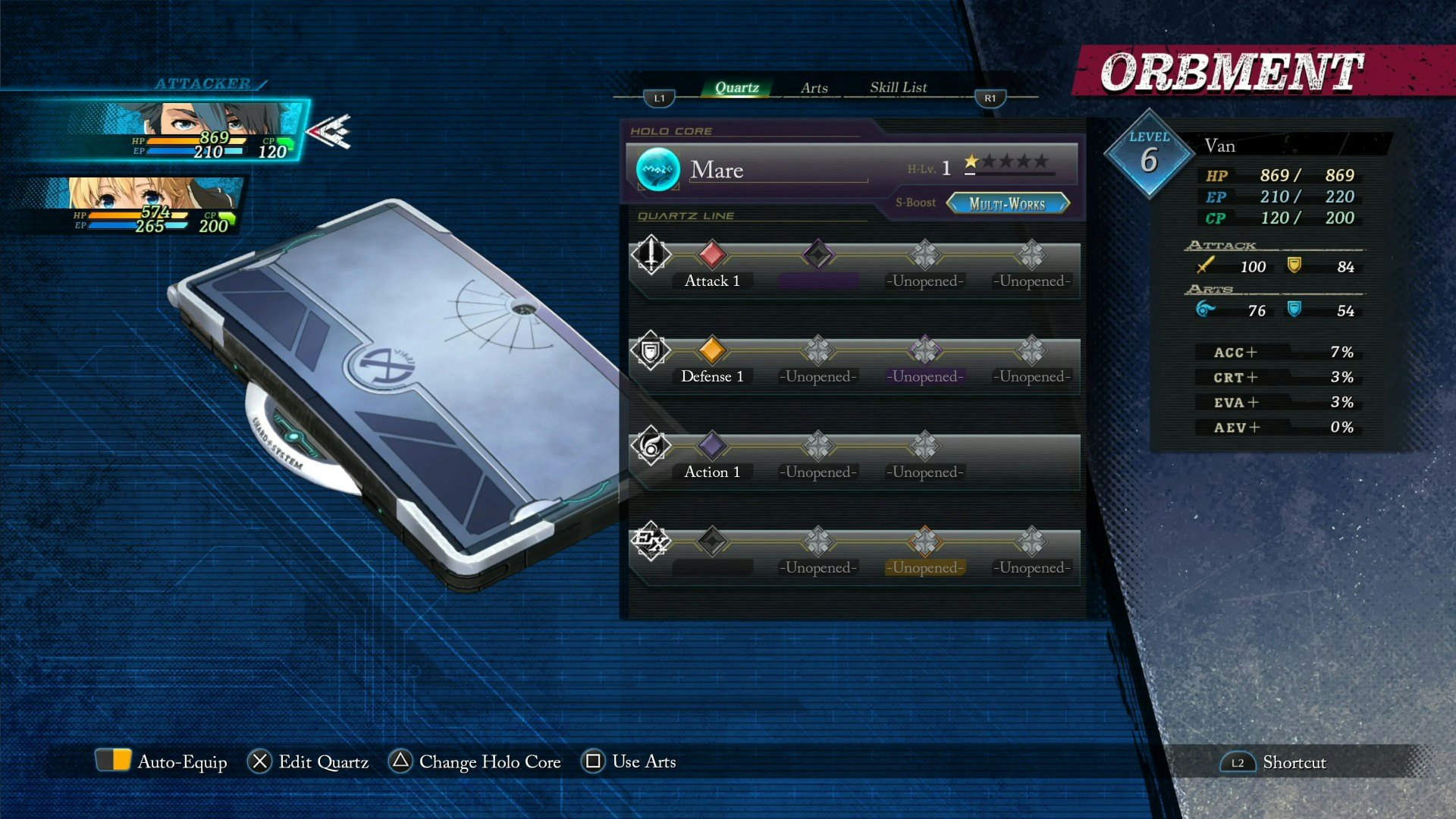
The expansive world of the Trails games has stepped into the modern age. As I walk the streets of the Calvard Republic, people sport portable hookahs that are basically vape pens, my main character drives a souped-up pickup truck, and a famous movie star moonlights as a high-tech Cat Woman. This series has come a long way, but just like the world itself, Trails Through Daybreak is a gorgeous, jaw-dropping evolution that pushes Falcom’s series in a bold new direction. It’s quite simply one of the best RPGs of the decade, if not ever made.
The Legend of Heroes: Trails Through Daybreak is the 11th mainline game in what’s known as the “Trails” series and was originally released in Japan three years ago. Every Trails game is connected and tells one continuous story about the continent of Zemuria, even though there are sub-series that focus on specific countries or characters.
Daybreak is arguably the best starting point Trails has had since the very first game, and genuinely feels like a soft reset, the push forward the series has desperately needed for years. It’s built on a new engine, overhauls the combat system, introduces a massive new section of the world, and more. Make no mistake, there’s still copious amounts of references and payoff for longtime fans, but beginners can jump right in and be fine.
Kickin’ It in Calvard

Daybreak takes place in the Calvard Republic, a democratic country that’s in the midst of a massive industrial revolution caused by Orbal technology. This has allowed the country’s culture and society to flourish, as well as criminal organizations and the underworld. You play as Van Arkride, the head of Arkride Solutions who’s known as a “spriggan,” a kind of handyman who takes on odd jobs, no matter the moral or legal dilemma.
What’s fascinating about Daybreak is that it’s abundantly clear Falcom has taken lessons from each of the first sub-series games in the franchise, and directly applied those here. Like the Trails in the Sky games, Daybreak has a ragtag group of characters that create a found family. The dense politically-driven story recalls the Crossbell games, and you can explore a rich tapestry of culture and cities, like you could in Cold Steel. All of the best elements of those games have been fused together here, and while it’s not completely seamless, it’s incredibly compelling.
Because this is the first game in a series set in Calvard, we’re introduced to a whole wealth of new characters and locations that slowly set up for an explosive finish. But that’s what Trails has always done best, and boy does it nail it here. Daybreak dedicates dozens of hours to building its rich world and fleshing out its characters, and not just the main party but a wealth of side characters as well. Daybreak’s story structure is broken into chapters, with each chapter taking you to a completely unique location, and adding a brand new party member who becomes an “employee” of Arkride Solutions. In one chapter, you visit a desert metropolis filled with casinos and a ritzy hotel, while another takes you to the grand ruins of an ancient palace.

This is, by far, some of the best storytelling the Trails series has ever had, with complex organizations and characters whose stories all tie together. Trails has never shied away from tough subjects, but some of Daybreak’s themes actually surprised me as it dives into topics like social classes, racism, grief, generational trauma, and even acceptance and coming out. Crucially, however, Daybreak doesn’t just gently touch on these themes, but in almost every case has something meaningful to say about them or a message to impart. Unlike a lot of other big RPGs, these themes aren’t simply window dressing, but vital pieces of the game’s vision and personality. It makes Daybreak feel like a scrappy upstart, a gem willing to go places and take chances that other games aren’t.
The characters themselves are a huge part of this, particularly Van, who’s become one of my favorite protagonists of all time. Van is a fascinating break from your usual RPG protagonist, as he’s an already world-wise 24-year-old man with a dark past that you uncover throughout the game. A major point of Daybreak’s story is gray morality, with Van and his companions not afraid to get their hands dirty for the greater good. Van himself is a complex multilayered character, someone that’s not afraid to blackmail a criminal, but also lights up like a little kid over decadent desserts. There’s even a consistent and genuinely funny running joke about him being the “old man” of the party.

But past Van himself, Daybreak has a phenomenal ensemble cast, with each and every party member having their own storyline that runs alongside the overarching plot. I’ve spent hundreds of hours with characters across the Trails series, but after just one game, some of Daybreak’s are my absolute favorites in the whole franchise. Particular highlights are the hot-headed and debaucherous, but secretly insecure, Aaron, and the stoic and brusque Bracer Elaine, who’s become something of a celebrity against her will. Each and every party member or major character has layers, and a huge part of Daybreak’s side activities are the bonds Van forms with them.
Again, I have to clarify that Daybreak’s story is a slow burn, and much of your time is spent wandering around various cities completing Spriggan Requests people have posted on notice boards. This intentional world- and character-building can make the first half of each chapter feel slow, before things ramp up in the second half. The game’s pacing speeds up later in general, with final chapters packed with massive revelations and twists.
Arts and Crafts

What elevates Daybreak into being a great game is how compelling all of its systems are, linking those story beats together. There are a lot of systems at play in Daybreak, from relationships with each character that provide stat boosts and meaningful character moments, to an SP system that provides rewards for how well you complete jobs, and even a morality system that unlocks alternate story beats.
All of these various systems weave together and work in concert, making it feel like you're getting rewarded for everything you’re doing, whether that’s the main story or side quests. The only thing I wish is that the activities within side quests were a little more interesting — that’s far and away my only big problem with Daybreak. More often than not, the game’s side quests have fantastic little stories to tell, which can be both heartwarming and tragic, but the activities within them usually boil down to walking and talking to characters, or hunting a monster. There’s a clear formula the game uses with its chapters, but the investment in the story is typically enough to look past that.
The other factor here is the combat system, which is genuinely one of the best turn-based battle systems I’ve ever seen. This is one of the biggest changes for the franchise, as Daybreak uses a hybrid system that blends action and turn-based but always feels delightfully fast-paced. While wandering the field, you can use basic combo attack and dodge, directly hitting enemies in action combat. However, at any time you can hit a button to seamlessly activate turn-based combat, where your party and enemies take turns based on speed stats. On top of this, every major story battle or boss battle is turn-based. But, in general, the option to switch between action and turn-based feels fantastic and adds a dynamic feeling to battles.

Even the turn-based combat itself has been improved from past games, with small but important alterations to make everything play faster and smoother. Positioning is still critical, and characters have skills known as Crafts that all have an area of effect. On top of this, positioning characters next to each other allows them to give boosts, and use a follow-up combo on attacks.
The series’ Orbment system has also been overhauled, giving you even more options for building characters. Each character has slots in their Orbment where you can equip gems that grant access to magic spells, stat boosts, or various other effects. But these gems can also grant unique boosts to characters, like activating an elemental bonus on their attack.
Just like the rest of the series, Daybreak has a huge emphasis on strategy and equipping your characters, but everything has been tuned up a bit or altered to be more intuitive. It means that, by far, Daybreak is simply the most fun Trails game to play, on a simple mechanics level.
But when you combine that with the game’s smart overarching systems and incredibly compelling setting and story, you’ve got something truly special.
A True Evolution

As the credits rolled on Trails Through Daybreak, I immediately knew this was the best game in the series, and one of the best games Falcom has ever created. I didn’t have to think about it. I already feel an incredible attachment to Van and his friends, and can’t wait to see where things go next. The smart changes and updates to the series’ formula make Trails feel more modern and intuitive than ever, and the way the game’s systems all work together is admirable, rivaling the way Persona 5 links its mechanics together. Despite some slow pacing and formulaic side quests, Daybreak is an incredible RPG that shows a Falcom putting real, meaningful thought into how to evolve a beloved franchise.
Whether this is your first step into Trails, or you’ve been with it for over a decade, Daybreak is a definitive RPG experience that can proudly stand with the best.
9/10
The Legend of Heroes: Trails Through Daybreak launches on July 5 for PS4, PS5, Nintendo Switch, and PC.
INVERSE VIDEO GAME REVIEW ETHOS: Every Inverse video game review answers two questions: Is this game worth your time? Are you getting what you pay for? We have no tolerance for endless fetch quests, clunky mechanics, or bugs that dilute the experience. We care deeply about a game’s design, world-building, character arcs, and storytelling come together. Inverse will never punch down, but we aren’t afraid to punch up. We love magic and science-fiction in equal measure, and as much as we love experiencing rich stories and worlds through games, we won’t ignore the real-world context in which those games are made.







